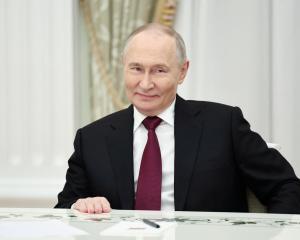
The Ukrainian military said it was still too early for it to begin withdrawing its own heavy guns. But its acknowledgement that most of the front was quiet suggests it too could push ahead with implementing a truce that had appeared stillborn when the rebels ignored it to launch a major advance last week.
The cautious good news from the front has come amid dire economic consequences for a country teetering on bankruptcy.
With the hryvnia currency in free fall this week as investors pull out cash, the central bank tried to call a halt on Wednesday by banning banks from buying foreign currency on behalf of their clients for the rest of this week.
Although banks could still trade with each other, by mid-morning there were no registered trades at any rate, leaving the currency in limbo. The previous day, the central bank rate based on reported trades had fallen 11 percent against the dollar.
Exchange kiosks on the streets in Kiev were selling limited amounts of dollars for 39 hryvnias, around 20 percent worse than the rates advertised in the windows of commercial banks where dollars were not available.
A construction worker exchanging dollars at a kiosk in a grocery shop in return for a bag filled with thousands of hryvnia, laughed and told shoppers: "Soon we will have to walk around with suitcases for cash, like in the 1990s."
The currency has lost more than half its value so far this year, after halving during 2014. The currency's collapse and the prospect of more controls have also sent Ukrainian bonds tumbling.
REBEL ADVANCE
The rebels initially spurned the Europe-brokered truce, due to come into effect on Feb. 15, insisting it did not apply to their main target, the town of Debaltseve, which they stormed four days later in one of their biggest victories of the war.
Kiev has since accused the separatists of reinforcing for a possible further assault to extend their control deeper into territory the Kremlin calls "New Russia". It says it is sceptical that rebel withdrawals of weapons are genuine and that fighting has taken place near the port of Mariupol, which it fears is the next rebel target.
But for now, the fighters appear determined to be seen to be moving to implement the agreement, which calls for artillery to be pulled from the front to protect civilians.
Reuters journalists, operating independently in rebel-held territory saw columns of howitzers being driven away from the front in several locations on Tuesday and Wednesday.
A column of 24 self-propelled howitzers, which resemble tanks with giant guns that can only face forward, headed away from the front through the city of Makiyvka adjacent to the main rebel stronghold Donetsk. Another five were spotted driving away from the front near Yenakiyve further north.
Late on Tuesday, the rebels said they had pulled 100 artillery guns from the front during the first day of their operation, and promised that the Organisation for Security and Cooperation in Europe would be able to verify that they would remove the rest in coming days.
The OSCE says it cannot yet verify the withdrawal because the sides have not said how many guns were in place before the truce. It reported some shelling and shooting at various locations, including near Shyrokyne, a coastal town on the road to Mariupol where Kiev has also reported fighting.
The Kiev military nevertheless said the number of ceasefire violations had "significantly decreased" for a second straight night, and its account of the past 24 hours was the calmest since the truce was agreed in the Belarus capital Minsk.
No shooting was recorded in the Donetsk, Luhansk and Mariupol areas, it said. Rebels had fired shells and mortars 15 times and opened fire four times with light weapons during the 24-hour period, and there had been a firefight on Tuesday afternoon at Shyrokyne.
Military spokesman Andriy Lysenko said: "For now there is still no order on the withdrawal of weapons, as the fighters have not yet fulfilled the first point of the Minsk agreement, to cease fire."
NOT GIVING UP
European countries that brokered the truce have not given up hope in it despite the rebel advance during its first days.
Kiev says it fears the rebels, backed by Russian troops, may be planning a further advance to capture Mariupol, a port of 500,000 people which is the biggest city in the two rebellious provinces that is still in government hands.
But the rebels, having achieved their main objective last week in capturing Debaltseve, which makes it easier to travel across their territory and defend it, may now be ready to stop.
Many Western countries believe Russian President Vladimir Putin's aim is to establish a "frozen conflict" with a breakaway territory outside Kiev's control, similar to smaller rebel regions that Russia protects in Georgia and Moldova. A stable ceasefire could suit that goal.
Moscow denies aiding its sympathisers in east Ukraine.
Foreign Minister Sergei Lavrov said many in Kiev and outside Ukraine wanted the ceasefire to fail, and called on the OSCE to do more to monitor the withdrawal of weapons.
With the battlefield quieter, the dispute between Russia and Ukraine has reopened on another front: natural gas. Moscow says it could cut Ukraine off within days over a payment dispute. Kiev says Russia failed to deliver gas already paid for. (Additional reporting by Pavel Polityuk and Peter Graff in Kiev; Writing by Peter Graff; Editing by Giles Elgood)












